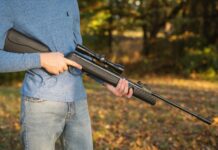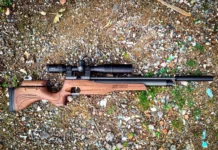A tiny fraction of whitetail hunters have taken a buck that scores over 170 typical or 195 nontypical, the minimums for entry into the Boone & Crockett record book. Many hunters feel like it’s just a stroke of luck to have a buck that size walk by, and many times it is. But that doesn’t explain why some hunters kill them with a shocking degree of regularity.
Several hunters have killed multiple B&C bucks over the years, which proves that they are probably doing things a little different than you and I are when you take to the whitetail woods. In talking to them, I have come up with a list if six things they’re doing that you’re probably not doing.
You’re Not Hunting Where They Live
This may seem obvious, but you have to hunt where there are. You don’t have to live there, but if you don’t have Booners where you live you must travel (or move.) Tim Young packed up and moved to Iowa and has shot two giants there and one on a roadtrip to Kentucky. Rod Owen, Adam Hays, Stan Potts and Ben Rising travel extensively to find and shoot big bucks in states other than their own.
“You have to find them first,” says Adam Hays, who has taken nine Booners including four over 200 inches. “Your best bet for finding a giant will be near sanctuaries where there is no or very limited hunting. These areas will be close to city limits, parks, industrial zones, wildlife refuges and even large tracts of land that allow no hunting. Hunting a specific animal will make you hunt harder and smarter also, just knowing he’s there!”
Rod Owen agrees.
“Killing a Booner isn’t the hardest part, the hardest part is finding one.”
Ben Rising has shot four Booners in the last two years. He says he often spends more time looking for a buck and getting access to hunt where the buck lives than actually hunting him.
You Don’t Understand How Fickle They Can Be
You can’t take chances with human intrusion, checking scouting cameras too often, or hunting in the wrong winds. To shoot a Booner you must do everything right, and get lucky, too. Patience is the key. Rod Owen tells about how he waited weeks for the perfect conditions to hunt a giant buck, but the wind switched so he literally got out of the stand and RAN all the way back to his truck.
“People go overboard trying to get intel on these big bucks and end up hurting themselves in the long run,” according to Ben Rising. They “dig too deep” he says, risking alerting the deer that he’s being hunted.
According to Adam Hays, patience is the #1 key.
“Sometimes the most difficult part of hunting a big buck is actually not hunting him at all,” he says. “having the patience and the discipline to wait until everything is perfect before diving in for the kill.”
You’re Not Willing To Do Whatever It Takes
You are spending your time watching Monday Night Football, you’re hanging out with buddies, you’re fishing when the big buck killers are scouting. The hunters who shoot Booners make sacrifices, and they are consumed by the pursuit and learning everything they can about the deer and the land they inhabit. The drive to shoot giant deer is at a level far above the average deer hunter.
“There are hunters and there are killers,” says Rising. “The drive has to be far greater if you are going to consistently kill big ones.”
With his truck stuck in a snowdrift, Steve Niemerg waited out a blizzard in a farmer’s house for two days, then instead of going home when the blizzard quit, he went hunting and killed a giant Booner that very evening.
You’re Not Hunting During the Peak Times
There are a few specific short periods each year when most Booners are shot. Hays is a big believer in the moon’s position as an influence of big buck movement. Rising says that waiting for the right moment is key.
Hays also claims that a wind that’s good for the buck and bad for you can be the best time to hunt.
“For me, the Holy Grail of whitetail hunting is finding a big buck’s weak spot, somewhere along his travel pattern where you can get within bow range of him while he’s using the wind to his advantage”
When a peak time arrives, you must put the rest of your life on hold. You might be surprised to discover that most of these true giants were not shot during the rut. Most big buck killers agree that they prefer to kill Booners before the chaos of the rut arrives and the deer are in more predictable patterns.
You’re Not Passing On Big Bucks
Those 170 and 180 bucks were once 150 bucks. If you can’t pass up a 4-year-old 150, you will probably never shoot a 6-year-old 180. A friend in southern Iowa who owns a large farm told me he kicked a guy out of their hunting group because he wouldn’t pass up the 4-year-olds that most people would drool over.
“People like Adam [Hays] and I have learned not to smoke the tag on the first 4-year-old 160 that comes by,” says Rising. “We only have one tag in Ohio.”
That’s a tough hurdle for most hunters to get over. If you are happy with a 150-160 then so be it, but if you want to kill bucks approaching 200, you will have to let them walk.
You’re Taking Shortcuts
Most hunters rely too much on gimmicks and don’t go to the extremes necessary. You aren’t choosing your entry and exit routes wisely enough, and you aren’t using discipline to wait for perfect conditions. These big buck killers are scent control fanatics, but they don’t use that as an excuse to take shortcuts with the wind. Scent control is an honorable goal, but the belief that you can totally eliminate your scent and ignore good woodsmanship is a ticket to forkhorn land.
Hanging a treestand during the rain, letting those cameras sit for weeks and only checking them with the right wind, having the patience to wait until everything is right — these are the characteristics of a person who kills Booners. Hunting mature bucks is all about strategic moves at the right time in the right place. There are no shortcuts, you must make every move with precision.











































